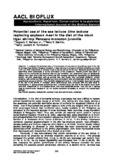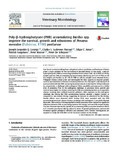Search
Now showing items 1-10 of 21
Potential use of the sea lettuce Ulva lactuca replacing soybean meal in the diet of the black tiger shrimp Penaeus monodon juvenile
(Bioflux, 2015)
To evaluate the biological value of incorporating the sea lettuce Ulva lactuca meal in the diet of the black tiger shrimp (Penaeus monodon), 3 diets were fed to groups of shrimps containing two levels (15% and 30% replacement ...
Improved resistance against White Spot Virus (WSV) infection in tiger shrimp, Penaeus monodon by combined supplementation of peptidoglycan and mannan oligosaccharide (MOS)
(Bioflux Society, 2014)
An eight-week feeding trial was conducted to evaluate the effects of combined supplementation of peptidoglycan and mannan oligosaccharide (MOS) in tiger shrimp, Penaeus monodon. Tiger shrimp (0.29 ± 0.02 g) were fed diets ...
A probiotic Bacillus strain containing amorphous poly-beta-hydroxybutyrate (PHB) stimulates the innate immune response of Penaeus monodon postlarvae
(Elsevier, 2017)
In this study, the PHB-accumulating Bacillus sp. JL47 strain (capable of accumulating 55% PHB on cell dry weight) was investigated for its effects on the immune response of giant tiger shrimp (Penaeus monodon) postlarvae ...
Induction of immunity and resistance to white spot syndrome virus (WSSV) in shrimp Penaeus monodon (Fabricius) by synthetic oligodeoxynucleotide and bacterial DNA
(University of the Philippines Los Baños, 2012)
Shrimps like all invertebrates are believed to lack true adaptive immunity but recent evidence indicate that they can be protected against pathogenic organisms by priming their immune system with immunostimulatory substances. ...
Evaluation of dietary freeze-dried Chaetoceros calcitrans supplementation to control Vibrio harveyi infection on Penaeus monodon juvenile
(Elsevier, 2014)
Effects of supplementation of diets with freeze-dried Chaetoceros calcitrans to control Vibrio harveyi infection are evaluated through immune responses, and disease resistance of juvenile Penaeus monodon. Total lipid and ...
Evidence of WSSV transmission from the rotifer (Brachionus plicatilis) to the black tiger shrimp (Penaeus monodon) postlarvae and means to control rotifer resting eggs using industrial disinfectants
(Bioflux, 2012)
Rotifers are considered possible vectors of the white spot syndrome virus (WSSV) and have been implicated in its recurrence in pond-cultured shrimp. However, direct evidence of the transmission and the pathogenicity of ...
Acute hepatopancreatic necrosis disease (AHPND) outbreaks in Penaeus vannamei and P. monodon cultured in the Philippines
(Inter Research, 2015)
Acute hepatopancreatic necrosis disease (AHPND) has recently emerged as a serious disease of cultured shrimp. It has also been described as early mortality syndrome (EMS) due to mass mortalities occurring within 20 to 30 ...
Poly-β-hydroxybutyrate (PHB) accumulating Bacillus spp. improve the survival, growth and robustness of Penaeus monodon (Fabricius, 1798) postlarvae
(Elsevier, 2014)
Low larval survival resulting from suboptimal culture conditions and luminous vibriosis poses a major problem for the larviculture of penaeid shrimp. In this study, a poly-β-hydroxybutyrate (PHB) accumulating mixed bacterial ...
The potential effect of greenwater technology on water quality in the pond culture of Penaeus monodon Fabricius
(Wiley, 2015)
Whitespot syndrome virus (WSSV) has caused severe production drops in the shrimp industry. Numerous scientific manuscripts deal with WSSV epidemiology, but reports on minimizing disease outbreaks through ecological means ...
Effect of three innovative culture systems on water quality and whitespot syndrome virus (WSSV) viral load in WSSV-fed Penaeus monodon cultured in indoor tanks
(Elsevier, 2012)
White spot syndrome virus is the most important among the shrimp diseases. It has been devastating the shrimp industry for more than 3 decades. Previous studies reported that greater percentage of yellow colonies on ...











